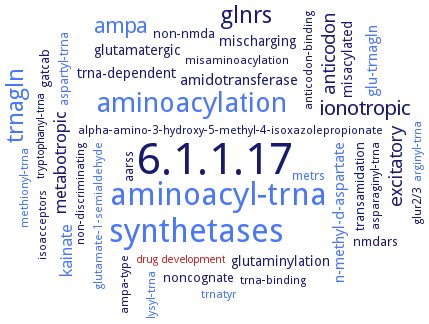6.1.1.17: glutamate-tRNA ligase
This is an abbreviated version!
For detailed information about glutamate-tRNA ligase, go to the full flat file.

Word Map on EC 6.1.1.17 
-
6.1.1.17
-
synthetases
-
aminoacyl-trna
-
aminoacylation
-
glnrs
-
trnagln
-
ampa
-
ionotropic
-
excitatory
-
anticodon
-
metabotropic
-
kainate
-
glu-trnagln
-
amidotransferase
-
n-methyl-d-aspartate
-
misacylated
-
glutamatergic
-
mischarging
-
trna-dependent
-
glutaminylation
-
non-nmda
-
noncognate
-
nmdars
-
transamidation
-
aspartyl-trna
-
gatcab
-
aarss
-
metrs
-
trnatyr
-
isoacceptors
-
lysyl-trna
-
non-discriminating
-
misaminoacylation
-
alpha-amino-3-hydroxy-5-methyl-4-isoxazolepropionate
-
ampa-type
-
glutamate-1-semialdehyde
-
arginyl-trna
-
asparaginyl-trna
-
anticodon-binding
-
glur2/3
-
methionyl-trna
-
trna-binding
-
drug development
-
tryptophanyl-trna
- 6.1.1.17
- synthetases
- aminoacyl-trna
- aminoacylation
- glnrs
- trnagln
- ampa
-
ionotropic
-
excitatory
-
anticodon
-
metabotropic
- kainate
- glu-trnagln
-
amidotransferase
- n-methyl-d-aspartate
-
misacylated
-
glutamatergic
-
mischarging
-
trna-dependent
-
glutaminylation
-
non-nmda
-
noncognate
-
nmdars
-
transamidation
- aspartyl-trna
- gatcab
-
aarss
- metrs
- trnatyr
-
isoacceptors
- lysyl-trna
-
non-discriminating
-
misaminoacylation
-
alpha-amino-3-hydroxy-5-methyl-4-isoxazolepropionate
-
ampa-type
- glutamate-1-semialdehyde
- arginyl-trna
-
asparaginyl-trna
-
anticodon-binding
-
glur2/3
- methionyl-trna
-
trna-binding
- drug development
-
tryptophanyl-trna
Reaction
Synonyms
bifunctional aminoacyl-tRNA synthetase, bifunctional glutamate/proline-tRNA ligase, D-GluRS, discriminating GluRS, EC 2.7.2.13, Ec-GluRS, EPRS, ERS, Ers2, GltX, GluRS, GluRS1, GluRS2, GluRSAt, Glutamate--tRNA ligase, Glutamate-tRNA synthetase, Glutamic acid translase, Glutamic acid tRNA ligase, Glutaminyl-tRNA synthetase, Glutamyl tRNA synthetase, glutamyl-prolyl tRNA synthetase, glutamyl-prolyl-tRNA synthetase, glutamyl-Q tRNAASp synthetase, Glutamyl-transfer ribonucleate synthetase, Glutamyl-transfer ribonucleic acid synthetase, Glutamyl-transfer RNA synthetase, Glutamyl-tRNA synthetase, glutamyl-tRNAsynthetase, GtS, More, P85, surface-exposed glutamyl tRNA synthetase, TM1351, tRNA modifying enzyme, YadB


 results (
results ( results (
results ( top
top





